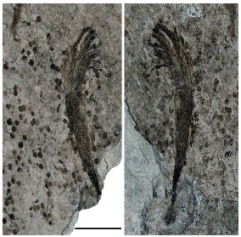
Scientists have recorded the discovery of a new formation of fossils which could represent the oldest example of macroscopic and morphologically complex life forms. The fossils also raise the 'intriguing possibility’ that the widespread glaciations of the 'Snowball Earth' period drove the evolution of complex life. Sarah Day reports.
Geoscientist online, 22 February 2011 The discovery, reported in the latest edition of
Nature, was made in the Anhui Province of South China. The Lantian biota, thought to be around 600 million years old, evolved only a few millions of years after the Snowball Earth event ended, in waters thought to have been incapable of supporting oxygen-based life.
The discovery could put back estimates about the origins of complex eukaryotes – organisms with a complex cell structure - by millions of years. Current record holder, the Avalon biota, is estimated to be around 579 – 565 million years old, its diversification triggered by the oxygenation of deep oceans. The new assemblage, named after the village near which it was found, is buried in between beds of black shale.
‘In most cases, dead organisms were washed in and preserved in black shales’, says Shuhai Xiao, Professor of Geobiology in the College of Science at Virginia Tech, and co-author of the paper. ‘But in this case, we discovered fossils that were preserved in pristine condition where they had lived – some seaweeds still rooted’.
The authors suggest that the presence of organisms living in anoxic waters can be explained by brief periods of oxygenation, which they exploited. When conditions became anoxic again, they were killed and preserved in the shale rocks, which are known to be excellent preservers of fossils.
‘The bedding surfaces where these fossils were found represent moments of geological time during which free oxygen was available and conditions were favourable’, says Xiao. ‘They are very brief moments to a geologist, but long enough for the oxygen-demanding organisms to colonize the Lantian basin and capture the rare opportunities’.
Some 3,000 fossils have been found, representing about 15 different species including seaweeds and worm-like animals. This makes them not only older, but taphonomically different to the Avalon biota, whilst nearly matching the latter in terms of diversity. All this, despite the fact that their evolution may have taken place only a short time, by geological standards, after the end of the Snowball Earth event.
‘These rocks were formed shortly after the largest ice age ever, when much of the global ocean was frozen’, says Xiao. ‘By 635 million years ago, the Snowball Earth event ended and oceans were clear of ice. Perhaps that prepared the ground for the evolution of complex eukaryotes’.
There is still plenty of work to be done before the Lantian biota are fully understood, as co-author and Professor Palaeontology at the Chinese Academy of Sciences, Chuanming Zhou, explains;
'We will need to sample each layer [of shale rocks] to see whether there is any difference in oxygen content between layers with fossils and layers without'.
The research was supported by the Chinese Academy of Sciences, National Natural Science Foundation of China, Chinese Ministry of Science and Technology, National Science Foundation, NASA Exobiology and Evolutionary Biology Programme, and a Guggenheim fellowship for Professor Shuhai Xiao.
- Journal reference: Xunlai Yuan, Zhe Chen, Shuhai Xiao, Chuanming Zhou & Hong Hua, "An early Ediacaran assemblage of macroscopic and morphologically differentiated eukaryotes", Nature, Vol. 470, No. 7334, 17 February 2011, pp. 390 - 393.